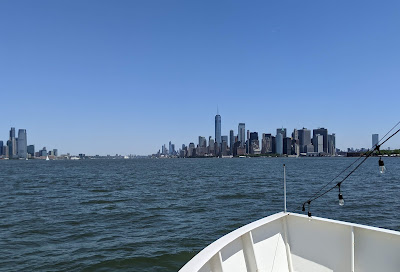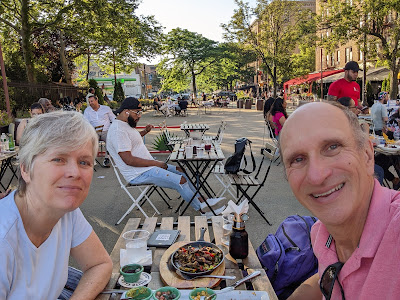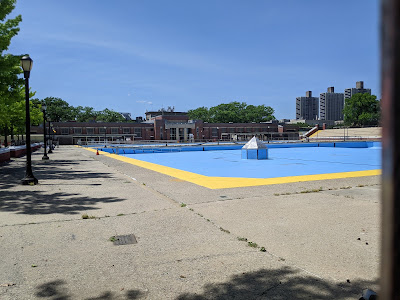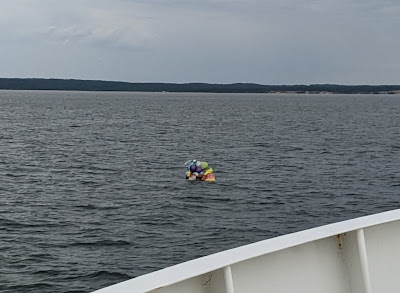After my last post our speed improved to the point we were able to pass Shark River and make Sandy Hook, enjoying dinner under way. We curled around the hook just before sunset and dropped anchor just off the Coast Guard station at the north end of the embayment (map). We had a lovely sunset and a comfortable evening.
 |
| Off the coast of NJ we passed one of the largest pods of dolphins we've seen in the wild. |
Saturday morning we weighed anchor with the turn of the tide for a downhill run to the city. New York harbor is easily the busiest and most chaotic place we ever transit, but it's now so familiar that it's no big deal, and we can enjoy the sights and the choreographed dance of ferries, tugs, and tour boats. A beautiful Saturday also meant a fair number of pleasure craft, somewhat less choreographed.
 |
| I saw several full breaches but could never snap one. This partial breach was the best I got. |
The combination of being able to bypass Chesapeake and Delaware Bays on the outside, and then getting an immediate pair of windows to transit the NJ coast, put us in New York Harbor a full two weeks ahead of schedule. That's as it should be, as it's always better to have extra time at the destination rather than possibly having to battle adverse conditions just to make it. With plenty of time to spare, we decided to spend some time in New York City.
 |
| Lovely sunset off Sandy Hook. |
Long-time readers know that we always stop in Manhattan when we pass through, often for a week or longer. Heretofore that stop has always been at the anchorage near the West 79th Street Boat Basin, where, for $26 per day, we could land the tender and be right on the Upper West Side. It was a wonderful location, so we were disappointed when it closed last season for renovations, with a re-opening no sooner than 2025. We were among the very last transients to stop there, last October.
 |
| On our way in to the harbor we passed the maritime cadet training ship Empire State coming out under the Verrazzano Narrows Bridge. We normally pass her at her berth near the Throgs Neck. |
We steamed past the shuttered facility on our way upriver. I could not get a decent photo. Large signs affixed to the docks warn against tying up, and floats block the entrance. A handful of moorings are atop the main pier, just as they were when we visited early in the pandemic. Otherwise, aside from being devoid of boats, it looks no different from our last few visits.
 |
| Obligatory shot of the Statue of Liberty, with the Staten Island Ferry for good measure. |
We continued upriver past the George Washington Bridge and the Jeffrey's Hook light, aka the Little Red Lighthouse, to another anchorage run by the NYC Parks department, adjacent to their docks at Dyckman's Landing. The anchorage extends from Dyckman Street south all the way to just north of the bridge, a distance of some 1.2 nautical miles. In the past, only the north end has had moorings, but as we passed the bridge we noted mooring balls all the way to the end of the designated anchorage.
 |
| Approaching the Battery, the iconic lower Manhattan view. |
We called the marina on the radio to ask where to anchor, but they did not have a good answer for us, saying only that we could squeeze in between the southernmost moorings and the bridge. That was unworkable for several reasons, including the fact that it was outside the marked anchorage, too close to the bridge, and with a rocky bottom and rapidly increasing depth.
Instead we proceeded upriver until we were directly abreast of the Dyckman Street docks, and headed for the NJ side, where we dropped the hook 300 yards from shore in General Anchorage 17 (map), which extends all the way to the middle of the river. That made for a 3/4 mile tender ride to the dock, which was still closer than the south end of the anchorage, and also closer than we were at 79th Street.
 |
| The little red lighthouse and the great gray bridge. Dyckman Landing is just left of the lighthouse. |
After setting the hook I went to work on the tender VHF, whose display had gone completely blank the last time I used it. I think it's another corroded ZIF connector, and I got it working before reinstalling it, only to have it blank out again once the dink was in the water. I'll need to have another go at it; these connectors and ribbon cables are so delicate that it's best not to be too aggressive in any one sitting.
 |
| Our view to the west, the Palisades. Structures at top are the Novitiate of St. Michaels. I went to high school just a half mile beyond. |
We tendered ashore just before dinner time to get squared away. The staff, many of whom were transferred up from 79th, recognized us, and we chatted briefly about the closure and the differences between the facilities. Being out of the NYC anchorage meant we'd pay for dinghy landing only on the days we used it, and not every night in the anchorage, and so we just paid $35 for the day and headed off to explore the restaurant district.
 |
| The daytime view downriver. We're at anchor; our "wake" is all from outgoing tide. |
Dyckman Street is roughly the boundary between the Fort George and Inwood neighborhoods, and culturally part of Inwood, which is the northernmost neighborhood on the island of Manhattan. Nowadays the neighborhood is home to a large Dominican population, and every restaurant here, regardless of cuisine, has a Dominican flair. Mofongo is on almost every menu, even in the Italian joint, and the fried rice at the Sushi place is actually chofan. Our first night we ended up at one of the Mexican-styled places, Papasito, where we had a nice table in what used to be the street but is now a pedestrian mall.
 |
| Dinner al fresco on Dyckman Street. |
After dinner we walked around the corner of Broadway to the Fine Fare supermarket for a few essentials. Like many neighborhood groceries in NYC, they had a little bit of everything, but some staples come with stratospheric prices. Several smaller markets in the neighborhood provide a measure of competition. I spent a few hours across several days exploring the entire neighborhood on the e-bike.
 |
| The Dyckman Farmhouse, the last colonial-era single home in Manhattan, now a museum. |
The dinghy steering has been getting stiffer and stiffer of late, and I had to muscle it quite a bit that first evening. That's a problem if Louise needs to drive it, as she did for a full week when I landed in the hospital, and so I spent the next morning working on it. That involves pounding the steering arm out of its tube, cleaning out a bunch of old dried grease, and dealing with the corrosion inside the steering tube. This Youtube video does a great job of showing what's involved.
 |
| This rock in Inwood park bore witness to the purchase of Manhattan from Native Americans. It was moved to this spot, where an enormous tulip tree once stood, from elsewhere in the park. |
I don't have a shotgun brush, so I ended up pushing pieces of industrial Scotchbrite pads through the tube using a long 1/4" ratchet extension. During the process, my 2" extension leapt over the transom and went to the briny deep. Eventually I got it all cleaned out and lubricated, and the steering is very smooth now.
I also spent a couple of hours fixing the masthead light. That turned out to be a wire on the proprietary connector that had corroded through and broken off. The fix involved sitting on the radar platform, crammed between the radar array and the mast, and soldering the broken wire back on. It's working now, but I will have to keep an eye on it, because its only a matter of time before one of those joints breaks again.
 |
| Best shot I could get of the Grand Staircase in Highbridge Park. Yeshiva University is just above, on Amsterdam Avenue. |
Anchored in this part of the river, we are mostly out of the coastal migration of boaters, but we are squarely on the Great Loop, which continues up the Hudson to the Erie or Champlain canals. During the course of the week we were passed by a couple dozen loopers, many of whom I recognized from online forums, including the Executive Director of America's Great Loop Cruisers' Association. We were even hailed on the radio by friends on a familiar boat, Two by Two, as they passed by.
 |
| Two by Two, a Nova Scotia 47, passes close aboard on a greeting/photo op. |
Anchoring for a week meant running the generator daily, and with each successive run, the engine room exhaust fan, which had gotten wet in the great laundry overflow, was getting noisier and noisier. I took a couple of hours to pull the fan down and try to fix it. Unfortunately the setscrew for the blade is seized and stripped; the best I could do was oil the bearings, but that's not enough. I have a new fan on order to be delivered to our next dock.
 |
| The historic High Bridge aqueduct, as seen from the water tower. |
We spent six nights at anchor there, and made it ashore five days. One day we were pinned on the boat by high winds that had the Hudson whipped up into a frenzy. We hip-tied the dinghy due to the stress it was placing on the painter, and even then, two of the three lines we used parted. In the scramble to get another safety line attached without going overboard myself, I managed to lose the VHF weather cover over the side. Fortunately, I had a spare.
 |
| High Bridge Water Tower. |
In addition to going ashore most evenings for dinner, I also brought the e-bike ashore and spent a few days exploring the neighborhoods and several of the very large parks in northern Manhattan. I also crossed the Broadway Bridge over the Spuyten Duyvil Creek to Marble Hill, which, due to a straightening of the creek, is in the borough of Manhattan but is actually on the Bronx side of the river. A Target store is not far from the bridge, and I stocked up on a few things.
 |
| This wonderful NYC Parks pool complex, closed due to the pandemic, is adjacent the water tower. |
My exploration took me south along the Hudson River Greenway as far as the George Washington Bridge, closing the gap such that now I have ridden the entire length of the west side of Manhattan. I came back through Fort Tryon Park, home to the Metropolitan Museum of Art's The Cloisters, the only part of the park I had visited in my youth.
 |
| The bridge and water tower as seen from The Bronx. |
I rode several of the paved trails of Inwood Hill Park, which mostly comprises dense forest, the last primitive forest in Manhattan. I rode along the Harlem River as far south as the Hamilton Bridge, and through the length of Highbridge Park and across the High Bridge into the Bronx. When we passed under the High Bridge eight years ago, it had not yet reopened to pedestrian traffic. I stopped by the Water Tower that I mentioned when we passed below it back then. I rode back north along busy and vibrant St. Nicholas avenue.
 |
| Film and TV shoots are a regular occurrence in NY, and Dyckman was overrun with these trailers one day. I do not know what they were shooting. |
I very much enjoyed exploring the north end of the island, a slice of New York that I only saw out a car or bus window when I was young. NYC Parks has done a great job cleaning up and revitalizing all these urban gems. I had imagined that, during the course of the week, I would hop on the A train and head downtown, but the north end kept my attention the whole week. During the course of our stay we enjoyed dining at Papasito, Il Sole, Mamasushi, The Park View, and Tryon Public House.
 |
| Scooters are everywhere in NY now, and I thought nothing of these until I realized they were brand new and for sale by the general store behind them. |
We could easily have spent another few days in the neighborhood, but we were ousted by the tide. Our anchorage was just a mile from the Spuyten Duyvil railroad bridge, and so the logical route to Long Island Sound was through the Spuyten Duyvil, down the Harlem River to Hell Gate, and then out the East River to the Sound. Current in those channels can be over two knots, and that's not something we want against us.
The tide cycle dictated that yesterday was the right day to leave, where we'd have good tide beginning at 1:30pm, landing us in Port Washington around 4:30. We could have waited one more day, with today's fair tide running a little more than an hour later, but that meant possibly dealing with weekend traffic. And so we weighed anchor at 1:30 and pushed upriver to the railroad bridge, after which we had a nice push the whole way.
 |
| Mast lowered for transit. |
Long time readers may remember some drama when we did this the first time. Back then, we had a fixed mast height a little over 25', and since there are several 25' bridges on the route, we had to time not only the current, but also the tide level to clear the bridges. This time we simply lowered the mast, making the bridge heights a non-issue. I did have to fiddle for over an hour with the portable winch we use for that purpose; it turns out one of the power connectors was iffy.
 |
| Several buildings and this sign, for some reason in German, are new since our last transit of the Harlem River. |
With eight more years and thousands of miles of experience behind me, the cruise was much more relaxed. We enjoyed the sights along the river, photos of which I posted back in 2014. Other than a couple of Circle Line and one other tour boat, we had the river to ourselves. A fair current had us doing close to nine knots in places, and we whizzed through Hell Gate and the East River past numerous familiar landmarks.
 |
| Sandstorm sunset over Manhasset Bay. |
We had the hook down in Port Washington at 4:15, in a familiar spot (map). Perhaps too familiar; we both admit to a certain amount of PTSD anchoring in this same place eight months later. Nevertheless we splashed the tender and headed ashore for dinner at our favorite local joint, Amalfi's, a casual Italian place two doors down from the urgent care clinic and across the parking lot from the grocery store.
 |
| A short time later, with a sailboat for artistic verisimilitude. |
After dinner and some grocery shopping we returned to Vector, decked the tender, and enjoyed a fantastic sunset on deck. That took the edge off the PTSD, and it's good to remind ourselves that, of all the possibilities, this was really a good place to be when things went sideways. I had good care, and it was a comparatively easy and welcoming harbor for Louise to have to endure alone.
This morning we weighed anchor with the tide to continue east. We contemplated stopping in Northport, off Huntington Harbor, where our last visit was so rudely interrupted, but we had such calm conditions on the Sound that we decided to press on to Port Jefferson. Winds were very light today, so despite the weekend I only had to dodge a few sailboats. We did have to steer around the fishermen and even made a diversion of a hundred yards or so to scoop a large bouquet of helium balloons out of the water.
 |
| This bouquet of Mylar balloons was so big it showed up on radar. We made a hard right to intercept it. |
Update: We are anchored in Port Jefferson Harbor. It was raining when we came through the jetties, and in the low 70s, so we opted to just eat aboard and thus anchored in the northeast end of the harbor (map), closer to the entrance but further from town. A few die-hards were using the nearby beach. Tomorrow it's forecast to rain all day.
 |
| On deck. Someone's 40th birthday got away from them. |
In the morning we will weigh anchor and continue east toward the "forks," stopping if weather permits at our usual anchorage off Truman Beach. That will put us in Gardiners Bay a full week before our reservation in Greenport, and we'll likely cruise Gardiner and Peconic Bays a few days before setting in. We have friends on the south fork that we'll try to catch as well.
 |
| A lot smaller once you let the helium out. |
I might get a chance to post a quick update here before the chaos that is our annual visit to Southold begins next week. After that, my next opportunity to update will be westbound, on our way right back here. We'll be making tracks for Poughkeepsie, where we have plans to connect with family. I'm very, very far behind on answering comments here, and I'm hoping to carve out some time this week to catch up.



Great to hear from you, Clive. It would have been a hoot to reconnect on campus.
ReplyDelete